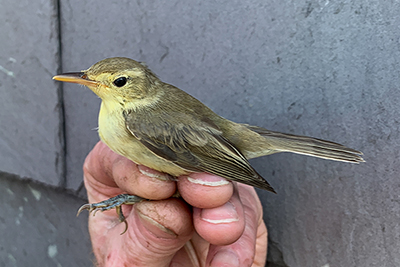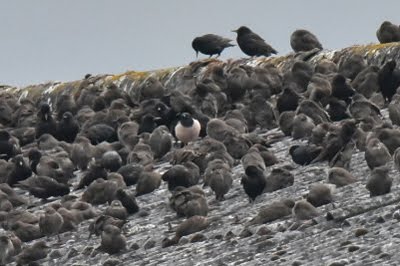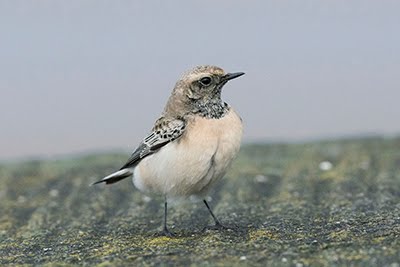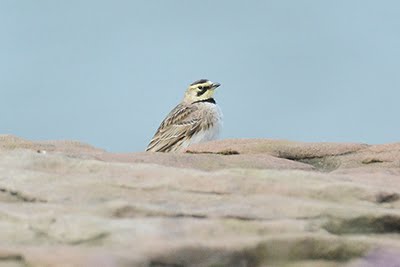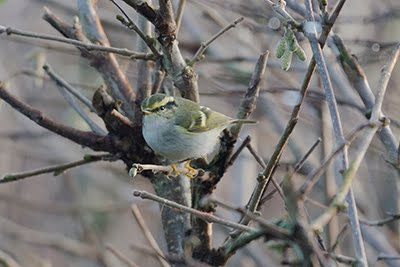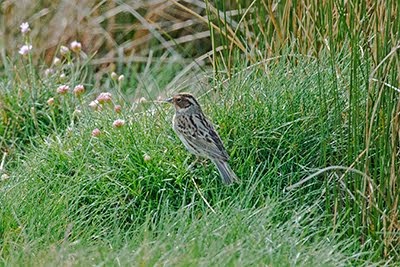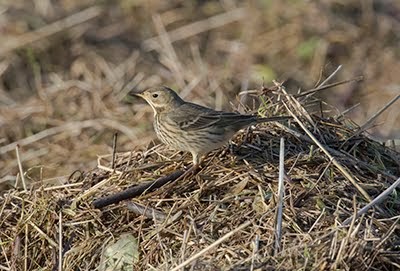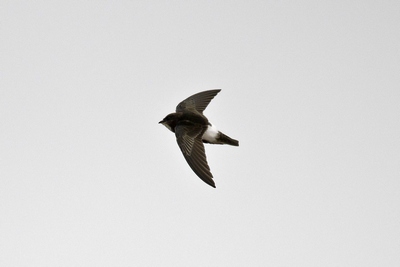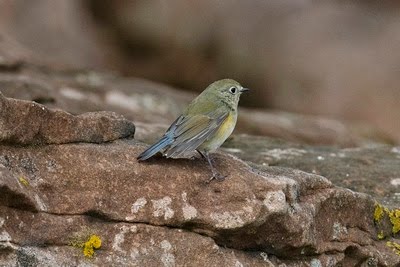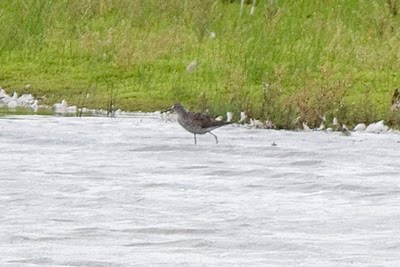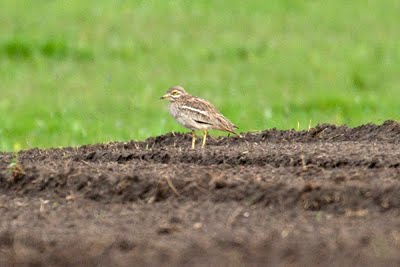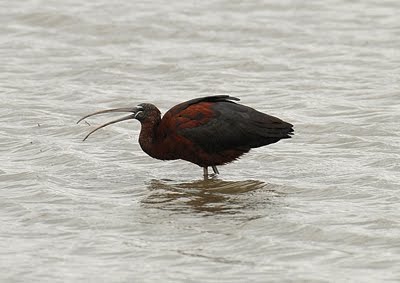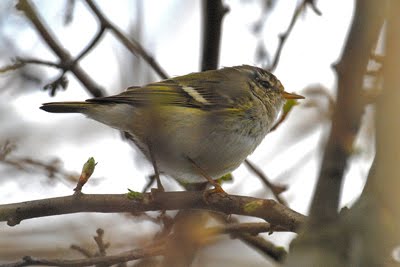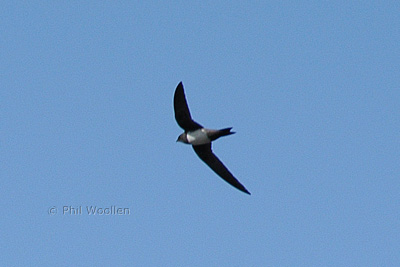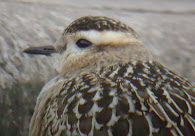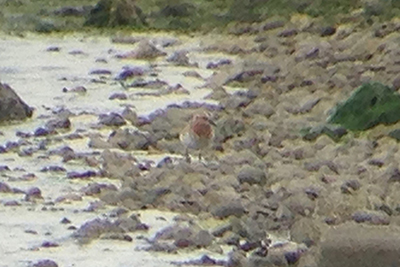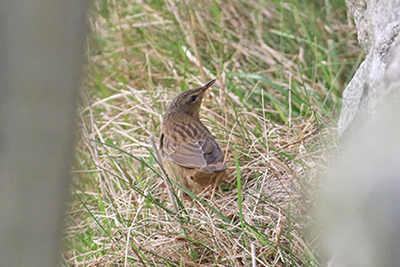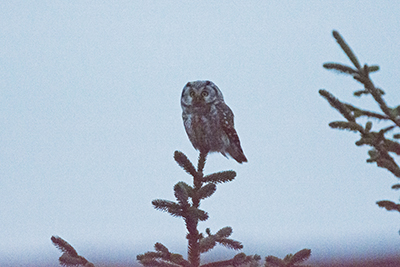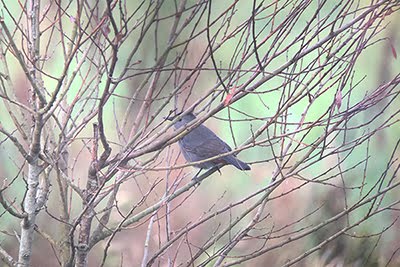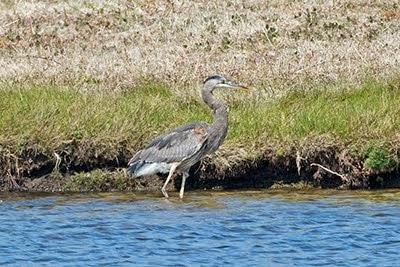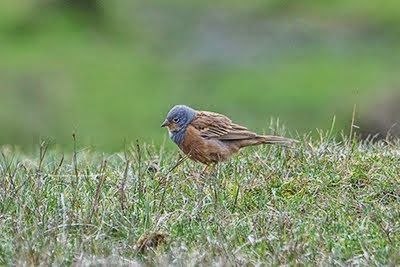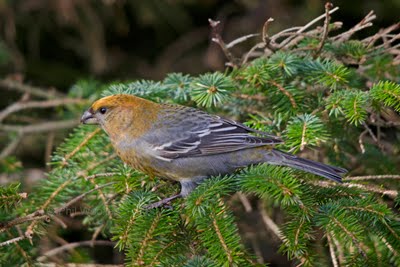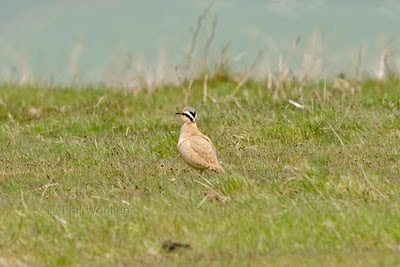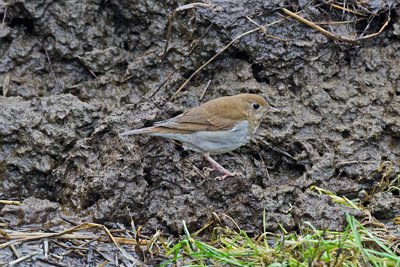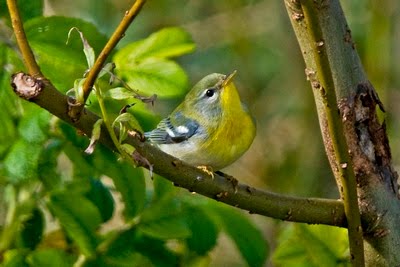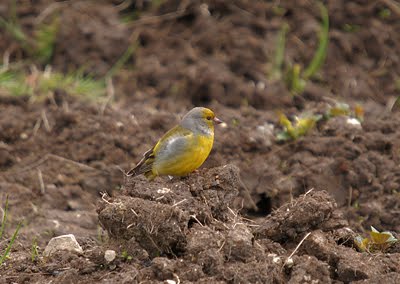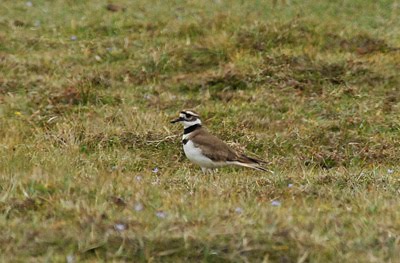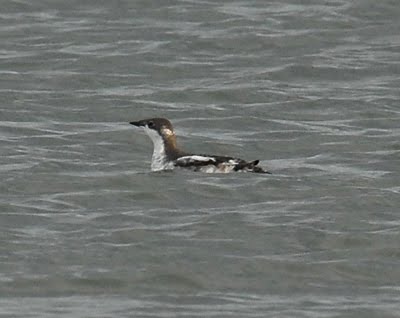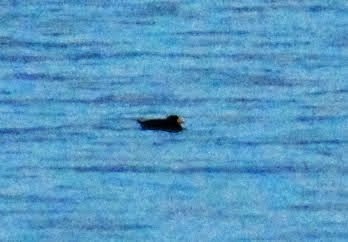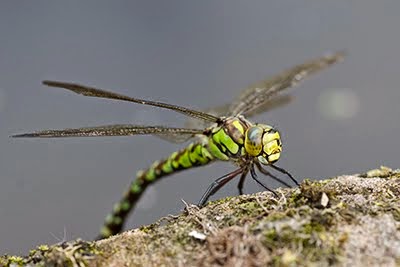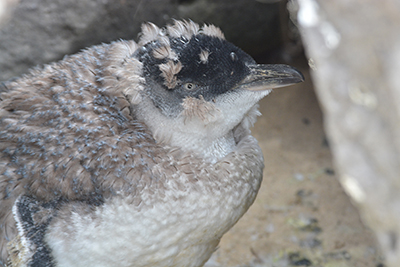25 Jun 2011
Laid up.
Surgery on a troublesome cervical disc has laid me up for a bit so not much birding being done until I'm more mobile again. A chance to catch up on some reading and sit in the conservatory watching the garden birds go about their business. I've no idea where the local Blackbirds are nesting as it looks as if the nest in the Laurel has been predated by the local Magpies yet again. There are two males vying for territory though - one in the back garden and one in the front!
All in all a quiet week although we did celebrate our 25th wedding anniversary the day before my operation. 25 years & I'm the only one that looks older!
19 Jun 2011
Linnets.
After the excitement of the last two weeks (Blyth's Reed Warbler, White-throated Robin, White-winged Scoter........) it was a fairly quiet weekend. A trip to Hilbre over the tide didn't reveal anything new either on land or sea but the local Linnets provided some photo oppurtunities as they flew around in small family groups. Most bizarre expeince of the day was catching a Mallard by hand and ringing it!
Photo above phone-scoped with iphone4 as an experiemnt!
A juvenile Kittiwake spent the tide roosting apart from the other gulls on Middle Eye but flew down on the Landrover track as I was leaving. A juvenile bird did a simialr thing last year before ending up dying so I hope this one fares better.
Its that time of year when butterflies and orchids start appearing and I too a walk along the lanes to where I regularly see both Bee & Early Spotted Orchids. A single Bee Orchid in in flower along the railway embankment and the only butterfly on the wing was a a large Skipper but they brightened up an otherwise dull and blustery day.
Photo above phone-scoped with iphone4 as an experiemnt!
A juvenile Kittiwake spent the tide roosting apart from the other gulls on Middle Eye but flew down on the Landrover track as I was leaving. A juvenile bird did a simialr thing last year before ending up dying so I hope this one fares better.
Its that time of year when butterflies and orchids start appearing and I too a walk along the lanes to where I regularly see both Bee & Early Spotted Orchids. A single Bee Orchid in in flower along the railway embankment and the only butterfly on the wing was a a large Skipper but they brightened up an otherwise dull and blustery day.
16 Jun 2011
White-winged Scoter
Josh Jones's recent correct identification of a Stenjnegeri White-winged Scoter in Ireland
Low and behold not more than 2 months later a 2nd calendar year bird of the American form deglandi was discovered lurking off the coast ofAberdeen
Melanitta fusca is currently treated as a polytypic species with subspecies M. f. fusca (North Europe east to the River Yenisey), M. f. deglandi (Nearctic) and M. f. stejnegeri (Asia , east of the Yenisey). A morphological analysis of seaducks (Tribe Mergini) concluded that deglandi and fusca are sister taxa (Livezey 1995. Condor97: 233–255), but stejnegeri was not included in this analysis. Adult male fusca is diagnosably distinct from deglandi and stejnegeri on the basis of both bill shape and coloration, and on the shape of the nostrils (Dwight 1914. Auk31: 293–308; Proctor & Pullan 1997. Birding World10: 56–61). All age and sex classes of fusca are diagnosably distinct from deglandi and stejnegeri on the basis of the contours of feathering at the base of the bill (Garðarsson 1997. Bliki18: 65–67). Although the described sample sizes are small, male fusca and deglandi are reported to differ diagnostically in tracheal structure and (presumably as a consequence of this) courtship vocalizations (Miller 1926. Am. Mus. Nov.243: 1–5; Cramp & Simmons 1977. Handbook of the Birds of Europe the Middle East and North Africa , Vol. 1). On average, the white subocular mark of adult male fusca is smaller than that of deglandi and stejnegeri (Dement’ev & Gladkov 1952. Birds of the USSR , Moscow
•
Velvet Scoter M. fusca (monotypic)
•
White-winged Scoter M. deglandi (polytypic, with subspecies deglandi and stejnegeri)
Velvet Scoter is on Category A of the British List. A further decision on possible specific status for M. d. stejnegeri has been pended awaiting analysis of vocalizations for these taxa. A manuscript on species limits in scoters has been submitted and will be published in due course.
With my own plans for Wednesdayfalling into disarray a quick phone call with Pod had me ringing Zoot to cadge a spare seat in his car for the long journey north on Tuesday. Leaving at stupid O'clock in the morning, along with Gregsy La, Zoot & Pod we stopped a couple of times for a caffeine stop before arriving on site to find around 20 -30 people looking out to sea.
With a horrible heat haze things were looking a bit difficult but after what seemed hours someone relocated the bird and everyone managed to get on it. After much discussion to ensure we were indeed looking at the right bird everyone was happy and I even managed a couple of terrible record shots that do at least show the key identification features.
The more bulbous bill has a distinct step in it when seen at high mag through the 'scope but in the photo this manifests itself as a more sloping profile when compared to the Velvet Scoters it was associating with. The grey / pink tip to the bill also contrasts with the yellow tip on that of 2nd calendar year Velvets whilst it's habit of leaning forward when moving through the water made it easy to pick out once you'd got your eye in. It was also pretty distinctive in flight with the heavier bill making it appear front heavy. There was a lot of glare even with the sun behind us and my eyes were soon smarting whilst Pod applied liberal doses of suncream to his rapidly pinkening dome.
It was nice to see so many Velvet Scoter and familiarise ourselves with this prized Wirral scarcity at distance on the water rather than in flight as is the usual viewing situation. A male Surf Scoter was an added bonus! A quick trip up the road to see the long staying King Eider on the Ythan was doubly rewarding with fantastic views of terns flying backwards and forwards with fish for their young.
A great day and nice to catch up with the lads again. Many thanks to the three of them for doing all the driving whist I rested my stinging eyes behind sun glasses on the back seat.
Low and behold not more than 2 months later a 2nd calendar year bird of the American form deglandi was discovered lurking off the coast of
Melanitta fusca is currently treated as a polytypic species with subspecies M. f. fusca (North Europe east to the River Yenisey), M. f. deglandi (Nearctic) and M. f. stejnegeri (
•
Velvet Scoter M. fusca (monotypic)
•
White-winged Scoter M. deglandi (polytypic, with subspecies deglandi and stejnegeri)
Velvet Scoter is on Category A of the British List. A further decision on possible specific status for M. d. stejnegeri has been pended awaiting analysis of vocalizations for these taxa. A manuscript on species limits in scoters has been submitted and will be published in due course.
With my own plans for Wednesdayfalling into disarray a quick phone call with Pod had me ringing Zoot to cadge a spare seat in his car for the long journey north on Tuesday. Leaving at stupid O'clock in the morning, along with Gregsy La, Zoot & Pod we stopped a couple of times for a caffeine stop before arriving on site to find around 20 -30 people looking out to sea.
With a horrible heat haze things were looking a bit difficult but after what seemed hours someone relocated the bird and everyone managed to get on it. After much discussion to ensure we were indeed looking at the right bird everyone was happy and I even managed a couple of terrible record shots that do at least show the key identification features.
The more bulbous bill has a distinct step in it when seen at high mag through the 'scope but in the photo this manifests itself as a more sloping profile when compared to the Velvet Scoters it was associating with. The grey / pink tip to the bill also contrasts with the yellow tip on that of 2nd calendar year Velvets whilst it's habit of leaning forward when moving through the water made it easy to pick out once you'd got your eye in. It was also pretty distinctive in flight with the heavier bill making it appear front heavy. There was a lot of glare even with the sun behind us and my eyes were soon smarting whilst Pod applied liberal doses of suncream to his rapidly pinkening dome.
It was nice to see so many Velvet Scoter and familiarise ourselves with this prized Wirral scarcity at distance on the water rather than in flight as is the usual viewing situation. A male Surf Scoter was an added bonus! A quick trip up the road to see the long staying King Eider on the Ythan was doubly rewarding with fantastic views of terns flying backwards and forwards with fish for their young.
A great day and nice to catch up with the lads again. Many thanks to the three of them for doing all the driving whist I rested my stinging eyes behind sun glasses on the back seat.
15 Jun 2011
Red-necked Phalarope.
A good find by Mark Gibson on Frodsham no. 6 tank Monday evening. Managed t oget down after work and join the throng of 4 birders viewing from the top of the embankment in the south west corner.
10 Jun 2011
Back to normality
After the excitement of the White-throated Robin & the weekends Blyth's Reedwarbler its back to a bit of normality with local birding. Plenty of activity in the garden with the appearance of several broods of young Goldfinches and Greenfinches amongst the tits on the feeders. I'm now having to fill them up more regularly again. The wrens above the porch have fledged but it was sad news on some of the nest boxes as some young have died during the recent wet and windy spell of weather. I've also found a Pied Wagtails nest with 4 dead young that were within a week of fledgling. It seems earlier broods have all got off safely but the colder snap meant starvation for some later ones.
John & I managed to ring a couple of broods of Swallows on the Wirral earlier this week and also caught a couple of adults. Stunning little birds. I've even managed a couple of Wirral Hobby's this week with one alongside the M53 at J 4 and one alongside the A540 near the Burton turning.
Jackdaws have also fledged locally and are flying around chasing the parents begging for food. I'm thinking of putting a box up for them in one of our taller trees to try and deter them from using our chimney.
Wader numbers on the Wirral shore are dropping as birds move north to breed but a quick evening visit to Hilbre was rewarded with a small group of summer plumaged Sanderlings but no further sign of the Blyth's Reed warbler. Incredibly two more have been caught and ringed at North Ronaldsay Obs and Calf of Man Obs this week but Hilbre remains at the forefront of spring Blyth's identification! There have been no other records apart from these ringed birds so it shows haw many may slip under the radar!
With several singing male Common Rosefinches turning up in the UK over the last week - including one on Anglesey - theres still hope for a Cheshire or Wirral bird......................................
John & I managed to ring a couple of broods of Swallows on the Wirral earlier this week and also caught a couple of adults. Stunning little birds. I've even managed a couple of Wirral Hobby's this week with one alongside the M53 at J 4 and one alongside the A540 near the Burton turning.
Jackdaws have also fledged locally and are flying around chasing the parents begging for food. I'm thinking of putting a box up for them in one of our taller trees to try and deter them from using our chimney.
Wader numbers on the Wirral shore are dropping as birds move north to breed but a quick evening visit to Hilbre was rewarded with a small group of summer plumaged Sanderlings but no further sign of the Blyth's Reed warbler. Incredibly two more have been caught and ringed at North Ronaldsay Obs and Calf of Man Obs this week but Hilbre remains at the forefront of spring Blyth's identification! There have been no other records apart from these ringed birds so it shows haw many may slip under the radar!
With several singing male Common Rosefinches turning up in the UK over the last week - including one on Anglesey - theres still hope for a Cheshire or Wirral bird......................................
7 Jun 2011
White-throated Robin.
A major twitch ensued yesterday when a White-throated Robin turned up in a mist net in the made up county of Cleveland. managed to get over later in the day with Jase, Mark & Henry and after an hours wait were treated to good views when the bird flew in from the adjacent 'Doctors' garden and ended up hopping on the road in front of us! It then flew back into the garden and after a two hour wait we decided to call it a day and head for home as the area was becoming more and more crowded. No pics as I was concentrating on using the bins! Great bird though and only be the second UK record (discounting a bird on the Isle of Man).
5 Jun 2011
Blyth spirit.
The phone rings. It's Steve. This usually means something good on Hilbre..........
'Phil, it's Steve. Have you got Barry & john with you?'
'Yes - whats up?'
Don't panic, cos I am, but I think I've just extracted a Blyth's Reed Warbler from the old Obs mist net. We nned to check the wing formual very carefully to be sure'.
PANIC, WHAT PANIC.
A brilliant reward for all the coverage this spring and reward for the belief thart the big one was just around the corner seeing as the first week of June is now the new end of April!
With the bird duly ringed and all measurements double and triple checked including doing the wing formula on both wings it was time for a few photo's and show the bird to those Obs regulars who'd managed to get a lift from the mainland.
Someone, who shall remain nameless, had lent his SD card for his son to try in his new Canon 550D yesterday and forgot to put it back in the camera. Hence the grotty pics taken with a mobile.
'Phil, it's Steve. Have you got Barry & john with you?'
'Yes - whats up?'
Don't panic, cos I am, but I think I've just extracted a Blyth's Reed Warbler from the old Obs mist net. We nned to check the wing formual very carefully to be sure'.
PANIC, WHAT PANIC.
A brilliant reward for all the coverage this spring and reward for the belief thart the big one was just around the corner seeing as the first week of June is now the new end of April!
With the bird duly ringed and all measurements double and triple checked including doing the wing formula on both wings it was time for a few photo's and show the bird to those Obs regulars who'd managed to get a lift from the mainland.
Someone, who shall remain nameless, had lent his SD card for his son to try in his new Canon 550D yesterday and forgot to put it back in the camera. Hence the grotty pics taken with a mobile.
Subscribe to:
Posts
(
Atom
)





























